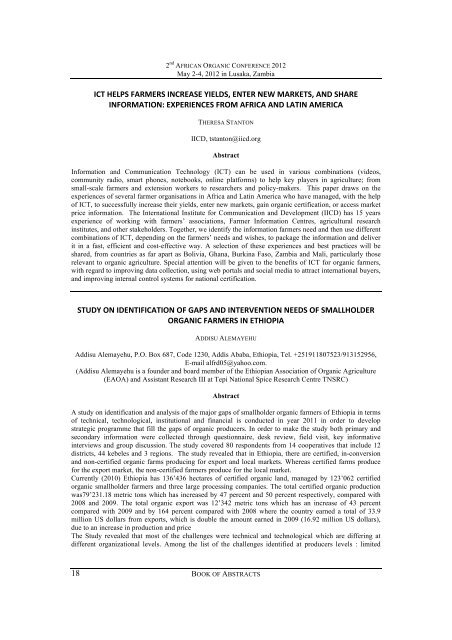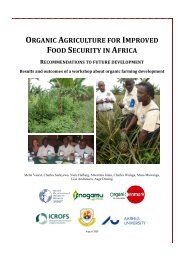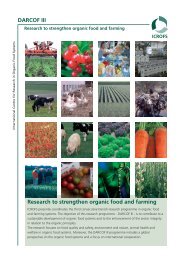The 2nd African Organic Conference â Mainstreaming ... - ICROFS
The 2nd African Organic Conference â Mainstreaming ... - ICROFS
The 2nd African Organic Conference â Mainstreaming ... - ICROFS
You also want an ePaper? Increase the reach of your titles
YUMPU automatically turns print PDFs into web optimized ePapers that Google loves.
2 nd AFRICAN ORGANIC CONFERENCE 2012<br />
May 2-4, 2012 in Lusaka, Zambia<br />
ICT&HELPS&FARMERS&INCREASE&YIELDS,&ENTER&NEW&MARKETS,&AND&SHARE&<br />
INFORMATION:&EXPERIENCES&FROM&AFRICA&AND&LATIN&AMERICA&<br />
THERESA STANTON<br />
IICD, tstanton@iicd.org<br />
Abstract<br />
Information and Communication Technology (ICT) can be used in various combinations (videos,<br />
community radio, smart phones, notebooks, online platforms) to help key players in agriculture; from<br />
small-scale farmers and extension workers to researchers and policy-makers. This paper draws on the<br />
experiences of several farmer organisations in Africa and Latin America who have managed, with the help<br />
of ICT, to successfully increase their yields, enter new markets, gain organic certification, or access market<br />
price information. <strong>The</strong> International Institute for Communication and Development (IICD) has 15 years<br />
experience of working with farmers’ associations, Farmer Information Centres, agricultural research<br />
institutes, and other stakeholders. Together, we identify the information farmers need and then use different<br />
combinations of ICT, depending on the farmers’ needs and wishes, to package the information and deliver<br />
it in a fast, efficient and cost-effective way. A selection of these experiences and best practices will be<br />
shared, from countries as far apart as Bolivia, Ghana, Burkina Faso, Zambia and Mali, particularly those<br />
relevant to organic agriculture. Special attention will be given to the benefits of ICT for organic farmers,<br />
with regard to improving data collection, using web portals and social media to attract international buyers,<br />
and improving internal control systems for national certification.<br />
STUDY&ON&IDENTIFICATION&OF&GAPS&AND&INTERVENTION&NEEDS&OF&SMALLHOLDER&<br />
ORGANIC&FARMERS&INÐIOPIA&<br />
ADDISU ALEMAYEHU<br />
Addisu Alemayehu, P.O. Box 687, Code 1230, Addis Ababa, Ethiopia, Tel. +251911807523/913152956,<br />
E-mail alfrd05@yahoo.com.<br />
(Addisu Alemayehu is a founder and board member of the Ethiopian Association of <strong>Organic</strong> Agriculture<br />
(EAOA) and Assistant Research III at Tepi National Spice Research Centre TNSRC)<br />
Abstract<br />
A study on identification and analysis of the major gaps of smallholder organic farmers of Ethiopia in terms<br />
of technical, technological, institutional and financial is conducted in year 2011 in order to develop<br />
strategic programme that fill the gaps of organic producers. In order to make the study both primary and<br />
secondary information were collected through questionnaire, desk review, field visit, key informative<br />
interviews and group discussion. <strong>The</strong> study covered 80 respondents from 14 cooperatives that include 12<br />
districts, 44 kebeles and 3 regions. <strong>The</strong> study revealed that in Ethiopia, there are certified, in-conversion<br />
and non-certified organic farms producing for export and local markets. Whereas certified farms produce<br />
for the export market, the non-certified farmers produce for the local market.<br />
Currently (2010) Ethiopia has 136’436 hectares of certified organic land, managed by 123’062 certified<br />
organic smallholder farmers and three large processing companies. <strong>The</strong> total certified organic production<br />
was79’231.18 metric tons which has increased by 47 percent and 50 percent respectively, compared with<br />
2008 and 2009. <strong>The</strong> total organic export was 12’342 metric tons which has an increase of 43 percent<br />
compared with 2009 and by 164 percent compared with 2008 where the country earned a total of 33.9<br />
million US dollars from exports, which is double the amount earned in 2009 (16.92 million US dollars),<br />
due to an increase in production and price<br />
<strong>The</strong> Study revealed that most of the challenges were technical and technological which are differing at<br />
different organizational levels. Among the list of the challenges identified at producers levels : limited<br />
18<br />
BOOK OF ABSTRACTS





